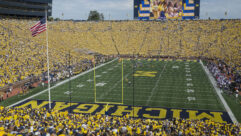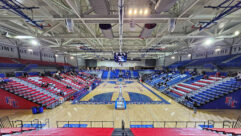TO FOCUS AND PROJECT
Jan 1, 2002 12:00 PM,
GLEN BALLOU
ONE THING ALMOST EVERY HOUSEHOLD, BOARDROOM, theater, corporation, school and church have in common is…lenses. Lenses are used in eye glasses, 35mm cameras, home theaters, home and corporate front and rear video projectors, 35mm slide projectors, and 8mm, 16mm, 35mm, and 70mm motion picture projectors, just to name a few.
Lenses are used to focus an image on some type of surface. No matter what specific application the lens is used for, the physics is the same. Lenses may look a little different, they may be different sizes, and they may or may not be adjustable. But the same equations and principles that work on one lens work on all lenses. Figure 1 shows the various types of lenses used in projection systems.
FOCAL LENGTH
PROBABLY THE MOST common lens specification is its focal length. Focal length determines the distance between the projector and the screen for a particular image size, or the distance the camera must be from a subject to photograph it clearly. The focal length of any lens is the distance between the film gate and the lens node, as shown in Figure 2. Due to the extremely high frequencies of optics as opposed to acoustics, the wavelength is shorter than the lens that is being used, so light travels in a straight line. (In acoustics, low frequencies bend around objects and corners making analysis more difficult.)
For long screen-to-film gate distances, Equation 1 can be used to find: image (screen) width, if the screen-to-lens distance and lens focal length are known; lens focal length, if the screen-to-lens distance and image (screen) width are known; and image-to-lens distance, if the image width and lens focal length are known.
image width/screen-to-film gate distance = film aperture width/lens focal length
EQUATION 1.
In each case, the film aperture width must be known. For instance, a 35mm double-frame slide has a film aperture of 1.345 inches, and a 35mm Academy standard motion picture film has a film aperture of 0.825 inches. The width can be replaced with height if we desire.
For short screen-to-film gate distances, such as are used in rear-projection systems, the classical lens equation, Equation 2, should be used. Refer also to Figure 3.
D = FL (2 + M + 1/M) + d
EQUATION 2.
whereDis the screen-to-film gate distance,FLis the focal length of the lens,Mis the magnification of the lens or image width/aperture width, anddis the internodal distance in the lens.
Most lenses are of the compound type, as in Figure 3, which requires knowing the internodal distance (d) of the lens if the projection distance is to be calculated exactly. Lenses often have one fixed lens and one moving lens, giving them a constantly changing value for d. In these cases, use the manufacturers’ prepared charts to determine screen-to-film gate distances.
As can be seen, a long focal length lens will produce a smaller picture than a short focal length lens for the same projection distance.
Zoom Lenses
A zoom lens has a variable focal length. In a zoom lens there are five lens elements: the relay lens, the compensator, the erector, the variator and the focuser lens (See Figure 4). The relay (2) gives the proper frame size. The compensator (3) is linked mechanically to the variator and compensates for focal plane shift. The erector (4) is stationary and rotates the image 180°. The movable variator (5) varies the focal length of the zoom. Finally, the focuser (6) is used to focus the picture. In a real lens, each group is often made up of multiple lenses like the types shown in Figure 1.
Common problems with zoom lenses are the change in focus when the zoom changes and the overall softness of the picture. The advantages of the zoom lens include the ability to adjust the lens’s focal length to change the throw distance and/or image size rather than adjusting the throw distance and/or image size to fit the lens, as required when using a fixed-focus lens.
LENS SPEED
THE SPEED OF the lens is probably the second most talked about specification. It is something like bragging about the horsepower in our cars: Bigger is better. Or is it? In our automobile, more horsepower allows us to accelerate faster but at the expense of fuel economy. In a lens, a larger diameter allows us to obtain more brightness, but at the expense of overall sharpness and cost. The f-number or f-stop is used to indicate the speed of a lens. The f-number is equal to the focal length of the lens divided by the effective diameter of the lens opening — Equation 3 — so for every inch of focal length there is 1 inch of effective lens diameter. For instance, an f/1, 6-inch focal length lens would have an effective lens diameter of 6 inches. An f/2, 6-inch focal length lens would have an effective lens diameter of 3 inches, and an f/6, 6-inch focal length lens would have an effective lens diameter of 1 inch. Note that as the lens diameter increases, the f-number decreases.
f-number = focal length of the lens/diameter of the lens
EQUATION 3.
The standard f-numbers are increased by the square root of the area doubled:
Furthermore:
EQUATION 4.
The f-number is rounded off for simplicity. The system of f-numbers allows us to easily double or halve the light entering or leaving the lens system by changing the f-stop by one number. The standard f-numbers are f/1, f/1.4, f/2, f/2.8, f/4, f/5.6, f/8, f/11, f/16, f/22, f/32 and f/45.
The lens may also be given a T-stop number, an individual calibration of a particular lens relative to its light-passing capabilities. This type of calibration takes into account the light lost by reflections and absorption as it passes through the lens elements, and the manufacturing tolerances.
In the f-number system of lens calibration, each f-value is computed mathematically from the physical dimensions of the lens system. Lenses calibrated by the T-stop method use a calibrating light that is passed through the lens; the loss of light through the lens is measured by means of a photocell. Thus, a T-stop calibration is an individual calibration of the true light-passing capabilities of a particular lens. As a rule, lenses used in the motion-picture industry are calibrated at regular intervals or after they have been serviced. The letter T is short for transmission.
Coatings
A plain piece of glass reflects light off of its surface back toward the source. To reduce the reflections, the elements of the lens are coated. Uncoated glass reflects about 6.5% of the light that hits it. When coated, this same glass reflects only 0.30%. In a multiple-element lens, each element must be coated, not just the outside element we can see. A 6-element uncoated lens may transmit 73% of the light; a coated one, 94% or more.
Coated lenses may be identified by shining a light on their surfaces and noting the color of the reflected light. If the lens is coated, the reflected light will usually appear light blue, red or brown.
A disadvantage of large f-stop lenses, besides their size, is that large-diameter elements translate to a short depth of field and less overall sharpness, particularly on the edges. This is caused by the sharp bending angles of the light at the edges of the lens, as illustrated by Figure 5. It is difficult to make large-diameter lenses optically good. If brightness is not a problem, a slower lens (one with a higher f-number, for example, f/5.6 instead of f/1.8) should be used since the overall picture quality is usually better.
ABERRATIONS
ABERRATIONS ARE things we don’t want in lenses. The optical axis of a lens is the one path through the optical system that does not change the direction of light rays transmitted by the lens, so it usually produces the most accurate reproduction. Spherical aberration is caused when the light passing through the center and edges of the lens do not focus on the same plane, resulting in a blurred image. Chromatic aberration is caused by the lens focusing different colors of the spectrum at different distances, causing color bands to appear at the borders between light and dark picture areas.
Newton rings, named after Sir Isaac Newton, is an interference pattern that appears when rays of light get in each other’s way. Generally, Newton rings are a series of irregular, concentric colored rings (kind of a Moire effect) seen when two transparent surfaces are almost, but not quite, in contact with each other or have the same curvature; such as the film and glass in glass-mounted slides.
Moisture condenses on lenses when a cold lens is placed in a projector and light is projected through it. A lens with moisture on it produces a soft, hazy, low-contrast picture. To eliminate this problem, cold lenses should be pre-warmed to room temperature.
LIGHT SOURCES
WE CAN’T TALK about lenses and their uses without talking a little about the equipment they work with, namely light sources, mirrors and screens. The best lens in the world will project a yellow image if the light source is a low-cost incandescent lamp. On the opposite end, an arc light source cannot make a poor lens look good — bright maybe, but not good.
When a mirror is used, as in most rear projection, it must be a front-surface mirror without aberrations. If a normal household mirror with a silvered rear surface is used, a double image will be projected on the screen, albeit one image will be much brighter than the other (remember uncoated glass reflections).
Screens can have gain or wide dispersion, but not both. A matte white screen is the standard with a gain of one. If we use a sheet tacked to the wall (possible gain of 0.6), we will see a picture, and it will disperse over 170°, but we will see a dull image. Using one of the many lenticular-type screens (with gains as high as 4 or 5) will produce a bright image on axis but a dull image off axis.
So what is the message of this Toolbox? Everything in moderation. Don’t buy the best lens in the world and marry it to an inferior screen and light source. Put a package together where each component is compatible with each of the other components through good design and engineering, and you will have the best system available for the price.
Glen Ballou owns Innovative Communications and is author of the third edition of The Handbook for Sound Engineers.










